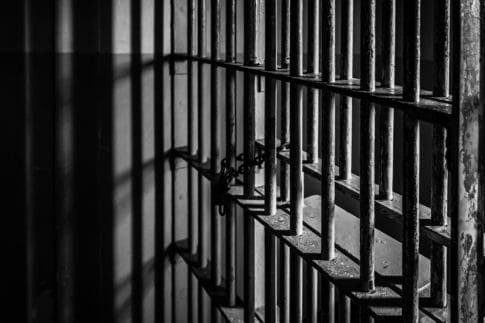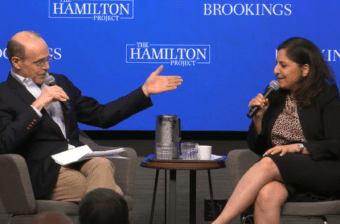In the two decades following 1980, the United States incarceration rate more than tripled. State officials carrying out stricter criminal justice measures faced increasingly crowded facilities and some turned to private companies to build or run their prisons. Recently, private prisons have become the focus of considerable attention as scandals resulted in major prison closings (e.g., Walnut Grove in Mississippi) and the Bureau of Prisons decided in August to phase out federal use of private prisons. This economic analysis explores the growth of private prisons and provides an economic framework for evaluating them.
The correctional system aims to protect the public by deterring crime and removing and rehabilitating those who commit it. Traditionally, the government has funded and operated correctional facilities, but some states and the federal government have chosen to contract with private companies, potentially saving money or increasing quality. There are several avenues through which private companies could in principle save costs relative to the public sector, including through operational innovations. Whether they do so in practice is a difficult question to test directly, however. Private prisons are unique in that, by contract, the types of prisoners that they are willing to accept are limited. This leads to challenges when trying to determine their effectiveness: prisons that do not accept unhealthy inmates or those serving sentences for violent offenses should not be directly compared to those that do because of the differences in costs required to serve different prison populations.
In addition, there may be differences in the effectiveness of public and private systems in promoting rehabilitation and minimizing recidivism. These differences may arise due to the incentives provided in private prison contracts, which pay on the basis of the number of beds utilized and typically contain no incentives to produce desirable outcomes such as low recidivism rates. The 2016 Nobel prize-winner in Economics, Oliver Hart, and coauthors explained that prison contracts tend to induce the wrong incentives by focusing on specific tasks such as accreditation requirements and hours of staff training rather than outcomes, and noted the failure of most contracts to address excessive use of force and quality of personnel in particular.
The Beginning of the Modern Private Prison Industry
As incarceration rates and sentence length rose, in part due to stricter sentencing laws in the 1980’s and 1990’s, prison populations exploded; by 1990, state prison populations reached 115 percent of their highest capacity. State officials traditionally finance the construction of new prisons using general obligation bonds, which require that voters approve the new project through a referendum. While voters supported criminal justice policies that increased incarceration, they did not always support the referenda authorizing expanded prison capacity; voters rejected an average of 60 percent of prison bond referenda in the 1980s.
The first private prison at the state level opened in Kentucky in 19861 and the first federal prison contract began in 1997. While states tend to contract out some prison services like telephone calls and medical care, this analysis focuses on prisons that are fully operated by private companies. Figure 1 shows the expansion of the private prison sector since data collection began in 1999. In 2014, 131,000 inmates were held in private prison facilities under the jurisdiction of 30 states and the federal Bureau of Prisons (BOP). Although less than 14 percent of all prisoners are held at the federal level, much of the growth in the overall private prison population has occurred at the federal level. The share of federal prisoners held in private prisons increased from 3 percent in 1999 to 19 percent in 2014—notably in immigration detention centers. However, in August 2016, the BOP announced their intention to phase out private prison contracts over the next five years.
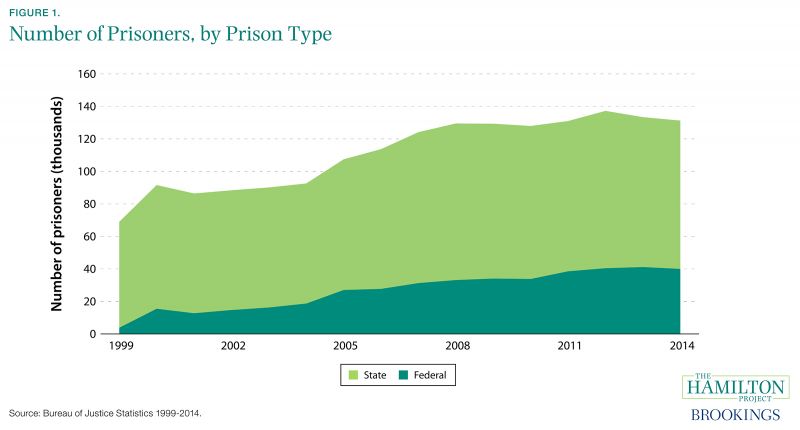
In response to voter rejection of funding for new prisons and orders by federal judges to relieve overcrowding, some states turned to private companies to build new prisons. Private prison arrangements are attractive to state officials in part because the companies are able to build prisons quickly and without the need for voter approval. Lease-purchase agreements are the most common type of arrangement, in which the state signs a long-term lease for the prison and receives the title when the debt and finance charges are fully paid.
Since their first use in Kentucky, private prisons have expanded to 29 other states. Figure 2 shows how states differ in their use of private prisons, depicting the percentage of a state’s prisoners held in private prisons, including those under the state’s jurisdiction that are sent to an out-of-state private prison (e.g. California and Hawaii send prisoners to out-of-state private prisons). This means that the map does not necessarily show the location of private prisons, but rather the extent to which the state contracts with these facilities.2
While 20 states do not use private prisons at all, a few states make very extensive use: for instance, nearly 44 percent of all New Mexico prisoners are held in private prisons. Northeastern states generally do not use private prisons, while Southern states and some Western states tend to make greater use of them. Some larger states with high incarceration rates also hold a disproportionately large share of state-level private prisoners. For example, private prisons hold less than 9 percent of Texas’ incarcerated population, but because of the number of prisoners held in the state, Texas accounts for nearly 16 percent of all state-level private prisoners.
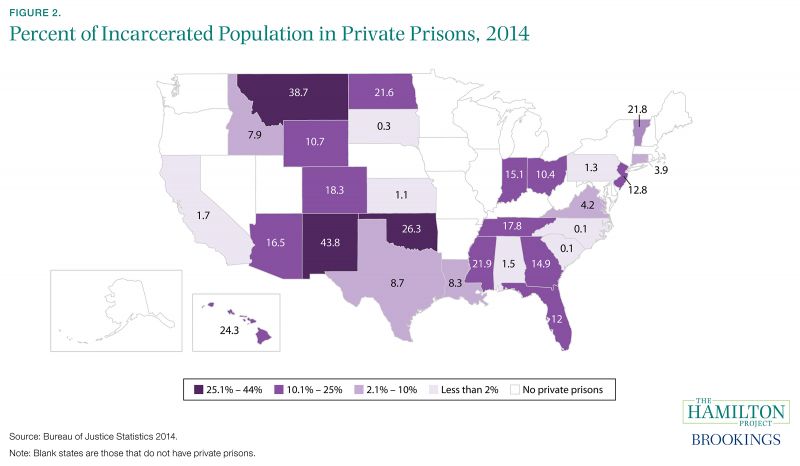
Considerations for Evaluating the Private Prison Market
Advocates for the use of private prisons argue that private prisons lower costs and improve quality by introducing competition. Although private prisons do compete with public prisons, the extent to which private firms compete with each other for prison contracts is fairly minimal because there are few firms in the business. Competition between firms may have previously played a larger role, as in 1999 there were 12 for-profit prison firms managing adult correctional facilities. Since then, however, eight of the firms competitors have been absorbed by other companies and only two new firms have opened.3 Based on available prison facility information, we calculate that the two largest private prison companies account for around 55 and 30 percent of all private prison beds, respectively, and the 3 largest firms provide over 96 percent of the total number of private prison beds. This type of market concentration is particularly visible when observing private prison companies within states. A single firm runs Mississippi’s three private prisons, while a different single firm runs all private prisons in California, Tennessee, and Texas.
Market concentration raises concerns that firms will not face sufficient competition to achieve the hoped-for benefits of lower prices and higher quality. In addition, consolidation of market share creates stronger incentives for each company to lobby for favorable legislation. For example, if there were many small private prison companies, no single company would stand to benefit in particular from legislation that increases mandatory minimums for sentence length. When a single company houses 55 percent of the state-level private prisoners, however, the benefits to lobbying become much more concentrated.5 To the extent that lobbying by private prisons increases the punitiveness of the corrections system, and over-incarceration is burdensome for the taxpayer and for people who are incarcerated, this may be a social cost associated with the use of private prisons.
Evaluating Private Prisons: Cost and Quality
Private prison companies aim to achieve the goals of the correctional system at lower cost and with higher quality. Advocates of private prisons argue that the competitive marketplace and absence of bureaucratic constraints allow private entities to develop efficient prison operation practices. Research on whether private prisons improve efficiency is limited, but does not contain strong evidence that private prisons are more efficient than their public counterparts.
In order to compare the cost of both public and private prisons, it is important to include capital costs of the prison facility and monitoring costs for the state agency that oversees the contract with the prison. In addition, one must account for differences in required security levels and inmate needs, which affect the expense of running a prison. Private companies are not required to release many details of their operations, including details on the cost of the services they provide, which limits the ability to make comparisons. The Government Accountability Office has concluded multiple times that the data are not sufficient to definitively claim that either type of prison is more cost-effective.
One particular challenge in comparing costs is the difference in inmate characteristics across prisons. The state of Arizona found that their minimum-security public and private prisons cost virtually the same amount per prisoner after adjusting for the medical costs incurred by public prisons whose inmates were in poorer health. By contrast, a separate Temple University study widely cited by private prison companies found savings of approximately 14 percent for Arizona minimum-security private prisons after valuing the depreciation of the older public facilities more heavily and including underfunded pensions for the public correctional officers. However, an internal investigation found that the authors of this paper failed to disclose their funding sources—the three major private prison companies—and the university disassociated itself with the report.5
Mississippi is a good state in which to evaluate public and private prisons because the state oversees both public and private facilities that house medium-security inmates and (unlike most states) it collects information on the operating and capital costs of its private prisons. Private prisons cost the state an average of $46.50 per prisoner per day in 2012, while the state’s comparable public facilities ranged from $35.11 to $40.47. Similarly, a study of prisons in Tennessee and Louisiana also controlled for the security levels and size of public and private facilities, finding that Louisiana’s private prisons were initially cheaper but the costs had risen to equal or more than public facilities and Tennessee’s private prisons cost savings came more in the form of forcing public facilities to lower costs. Finally, a meta-analysis of studies using available cost data found that private and public prisons were similarly costly.
Although many of the arguments in favor of private prisons focus on operational innovation, in practice the primary mechanism for cost saving in private prisons is lower salaries for correctional officers (about 65 to 70 percent of prison operating costs go to staff salaries). Private correctional officers are generally not members of a union and in 2015 they received salaries that were about $7,000 lower than the average public officer’s salary.
In addition to paying less per officer, private prisons also tend to hire fewer officers; private prisons report an average of one officer per 6.9 inmates compared to one officer per 4.9 inmates in public facilities. In principle, this difference could be associated with operational innovations that reduce cost without compromising quality. However, the two largest companies have each been involved in recent understaffing scandals; the Occupational Safety and Health Administration ruled against a private prison firm for severe understaffing and inadequate training in Mississippi in 2014 and a federal judge penalized another firm for misreporting its staffing levels in Idaho in 2013. The FBI even launched a criminal investigation into a private prison in Idaho in 2014 because the facility’s correctional officers compensated for understaffing by negotiating with prison gang leaders to maintain order through the threat of gang violence, earning it the nickname “Gladiator School.” A combination of lower pay, with OSHA’s findings of understaffing and inadequate training, may also help explain high turnover rates among private correctional officers; a 2008 Texas report found that the annual correctional officer turnover rate at the state’s seven private prisons was 90 percent, as compared to 24 percent for state-run facilities.
While private prisons may not consistently provide correctional services at a lower cost, it is important to consider whether they provide higher quality services at a given cost. There is a wide degree of variation on this front, particularly due to the differences across private prison companies and locations. Existing studies that attempt to quantify differences in quality across prison types are inconclusive. While some state-specific studies assessing quality measures such as escapes, suicides, assaults, and educational and vocational programming have not found major differences, others found that private facilities performed slightly better. The Department of Justice investigation into federal private prisons found substantial quality issues, including more safety and security issues.
Box 1. A Case Study of Prison Quality in Mississippi
A prison’s success at rehabilitating offenders and reducing recidivism are important aspects of its quality. Due to the lack of data available from private facilities, it is difficult to compare public and private prisons on these dimensions, but a case study from Mississippi is illustrative. Using data from the Mississippi Department of Corrections, a recent study found that those leaving Mississippi state prisons recidivate at about the same rate whether they were incarcerated in public or private facilities, although those serving in private facilities tended to receive more penalties and stay for a longer portion of their sentence length.
Another way of measuring how well a prison addresses the risk of recidivism is to look directly at the availability of programs aimed at improving a formerly incarcerated person’s chances at success, such as inmate job training, for which Mississippi provides data. Figure 3 shows the availability of job training programs per prisoner across Mississippi’s state prisons. Based on this analysis, private prisons compare favorably to public facilities; on average, private prisons offer almost 3 more program seats per 100 prisoners. There are substantial differences across individual facilities, and differences across prisons within sector are larger than the between-sector differences. Moreover, this comparison does not account for the different composition of inmate populations across prison types, and data are not available to allow us to adjust for these differences. Since prisoners who are more likely to benefit from job training are disproportionately found in state private prisons, it stands to reason that a higher level of programming would be expected from prisons with lower-security inmates.
The number of program spots reported reflect each program’s capacity not actual enrollment. While some prison contracts stipulate minimum levels of inmate programming, they lack the enforcement mechanism to ensure that the spirit of the requirement and the desired outcome of improved prisoner reentry are met. This is an important consideration because program capacity does not necessarily translate to prisoner training. For example, frequent shutdowns due to understaffing and inmate violence in the recently-closed Walnut Grove facility meant that inmates could not participate in programs; as a result, the program capacity presented below is an overestimate of Walnut Grove’s inmate training.6
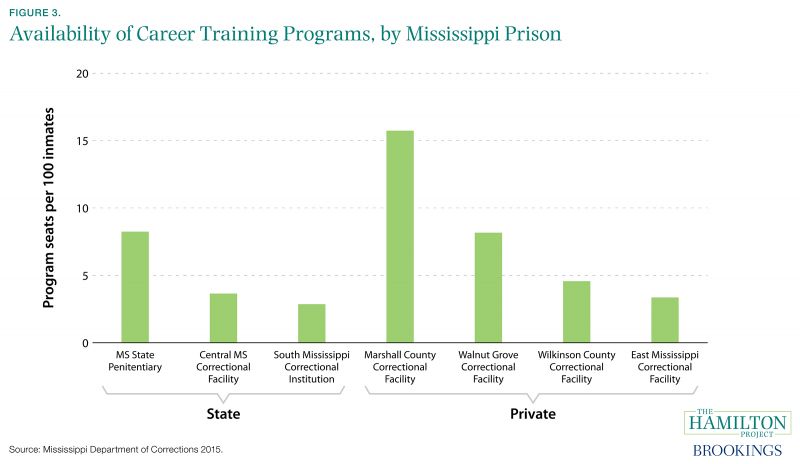
Conclusion
Private prisons do not currently offer a clear advantage over their public-sector counterparts in terms of cost or quality. The wide variation across prisons, differences between the public and private sector, and data limitations render a comprehensive, direct comparison of cost and quality across prison sectors infeasible. However, existing studies that attempt to account for differences in the population served show that private prisons do not offer clear cost savings or quality improvements. The monopolistic nature of the prison market and the misalignment of incentives for private prison companies provide potential explanations for these findings. States that continue to prefer the flexibility of private prisons to address surges in their correctional populations might consider policies to better align the incentives faced by those who run private prisons with public need, for example by tying desired outcomes like decreased recidivism directly to payments or the awarding of future contracts. Additionally, state evaluations of public and private facilities should include considerations of factors like inmate health and security needs when evaluating the cost and quality of their facilities.
We thank Emma Billmyer for excellent research assistance.
1 The Marion Adjustment Center was contracted in 1985 and began operation in January 1986.
2 The Bureau of Justice Statistics notes that states were allowed to include halfway houses and treatment facilities in the private prison population count, which means that some states without prisons that are privately operated may show a small private population (e.g. Connecticut).
3 CCA acquired Correctional Alternatives, Inc in 2013. GEO changed its name from Wackenhut Corporations and has acquired Dominion Management/McLoud Correctional Services (2000), Correctional Services Corporation (2005), CentraCore Properties Trust (2007), Cornell Acquisition (2010), and LCS Corrections Services (2015). Community Education Center (CEC) acquired CiviGenics in 2007.
4 Indeed, the top 3 private prison firms spent nearly $2 million combined on lobbying in 2015. While public correctional officers also organize to lobby for legislation that benefits their profession, the biggest public correctional officers association—California—spent only $66,000 in comparison.
5 The study was also criticized for exclusively taking into account factors that favor private prisons while excluding factors, like differences in inmate health, that tend to raise relative costs for public prisons.
6 While Marshall County Correctional Facility does stand out for its programming, a comprehensive assessment of the facility’s service quality would also need to include other aspects judged by the American Correctional Association, such as an ongoing investigation into allegedly pet-grade meat provided to inmates.

